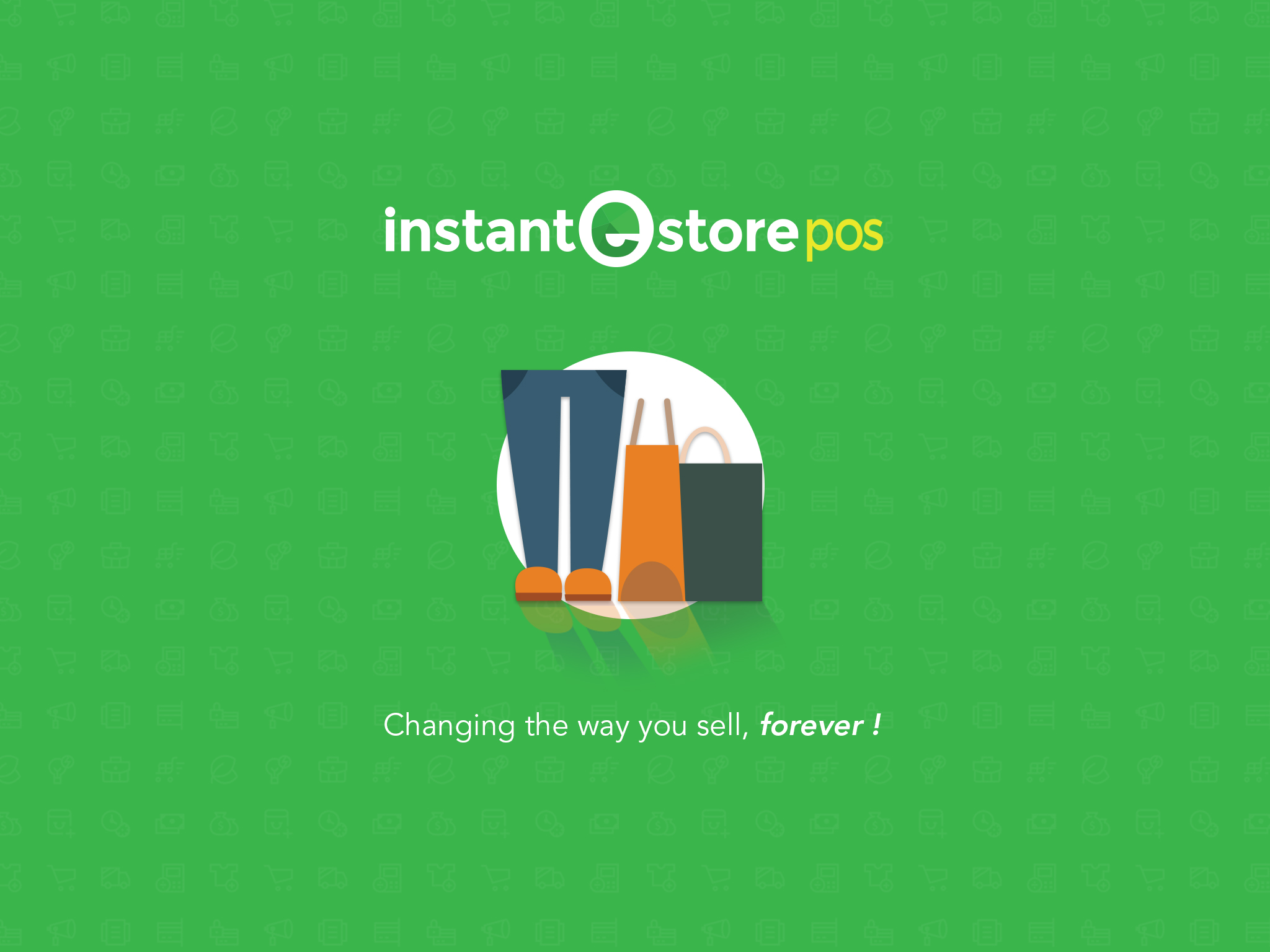
Learn how to set up our POS systems with this simple guide.

Find out how the Instantestore Point of Sales System can help you save time and generate sales!
The InstanteStore team just launched another 3 NEW responsive and mobile friendly templates (yay!) (more…)

An online store is, in essence, not much different than a physical one. eCommerce merely occurs in a different medium. Building an online store requires all the same attitudes and prep-work. Hence, we’ll draw parallels to a real-world retail store.
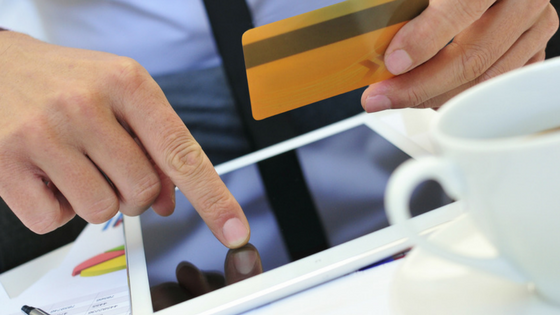
When I say transactional communication, the first thing that pops out is email. And why shouldn’t it? More than 90% of businesses use email as their defacto channel of communication. Be it sending shipping alerts, order status or just newsletters – Email works just fine. Though, what is unusual is that even heavily engaged mobile app users get emails.
Doesn’t sound like the best of the experiences.
Email is important and I am not trying to kill it here but not every single detail needs to be sent via Email. Product Managers are increasingly exploring better methods of communication. The underlying communication principle remains the same. As McKinsey consultants say:
MECE – Mutually Exclusive. Collectively Exhaustive.
Simply put, transactional communication takes place between a seller and a consumer. It occurs in commercial websites that offer users an opportunity to buy. The messages trigger to the targeted audience, who have taken an interest in a product or service and purchased it.
Now that technology is leaving footprints everywhere, one can book cabs, order food and groceries in just a couple of clicks. But without proper communication, it all falls apart. It’s annoying to make multiple calls or keep visiting a website just to know where you cab is or by when your food will be delivered. Constant real time status updates play an important role in these kind of situations.
Imagine your tummy is grumbling, and you are not sure when the food is going to arrive at your doorsteps. So you wonder if you should get a small snack to calm your stomach, or if you should keep waiting for the order to arrive. Updates like ‘Your food is being prepared, will be ready in a jiffy’ followed with ‘Your order is ready and out for delivery within 15 mins’, gives you assurance that food is on the way.
Post transaction communication is critical for any business. Users demand instant gratification and want to know everything about their purchase & shipment. Businesses today not only track, but also share every single piece of information about the transaction with the user.
For instance, Amazon offers the option to get updates every time their shipment moves. Result – users get dozens of notifications about where their order is, and when they can expect delivery.
Here are some basic check points for product managers to tick as they decided what channel to use for communication (related to transactions)
But, again, lot of users find sharing mobile numbers intrusive. App Push Notifications and web notifications come in handy for such scenarios. They help you communicate easily with the user (device) without being intrusive.
Show of hands: people who have had overwhelming anxiety while performing an online transaction. I am pretty sure half the people reading this have their hands held up high. Even though the digital age was embraced with open arms, users have always had panic attacks while buying things online.
In the beginning, people were hesitant and frightened to buy anything digitally. But now, users have evolved along with the whole online concept. Despite that, one skips a beat when one has no idea what is going on with the transaction.
It happens more than often that your internet dies or your screen just freezes mid payment. You don’t know if the payment has been made, if the order is placed or if you have to go through the procedures all over again. Who tells you that? Waiting for seconds seem life eternity in situations like these. Some sort of communication is necessary to avoid frustrated customers.
A clear mode of communication is necessary for effective communication. Lack of proper communication creates perplexed and unsatisfied customers.

Transactional communication comes in handy in numerous situation. Let’s say you have to buy new sunglasses, so you spend some time choosing the best (considering that you are choosy). Then you proceed with the payment. You are almost on your feet jumping for joy, but the ‘payment successful’ page doesn’t appear. You fall into a dilemma, wondering if your payment went through.
There are scenarios when you need to order something, and just finished the transaction. The payment has been deducted from your account, but it has not redirected to the main page and the error page appears.
Due to an absence of communication (or misleading communication) announcing if the order has been placed or not, you buy it again, ending up with double transactions sometimes. Though the money is refunded in a few days, the situation is disturbing.
Now that you agree that a mode of communication is necessary to keep things intact (yes, even your heart), let’s see which transaction communication channel you should be looking at.

Email and SMS is what most product managers depend on while communicating with end users. While these channels have existed for a while-given the options we have-the current user experience is limiting. Though they have their own set of advantages and disadvantages, let’s evaluate how the SMS, Web Push, Email and App push notifications fair on the identified metrics and how best the user experience can be improved.

Delivery reports are essential for you to know that users receive the information. Transactional communication plays a critical role for the consumer. Hence the delivery report is necessary to run things smoothly. Click through Rate (CTR) shows if the user has interacted with your message.
SMS – In SMS, one can check if the message has reached the users. The delivery report assures that the information reaches the user. As far as CTR’s are concerned, it is a cumbersome process to check whether the user has opened the message and if the they clicked a CTA.
Web Push – One can check the delivery report and the CTRs with ease by checking out the dashboard to see if the user clicked the messages. The open rates can also be tracked.
Email – It is possible to know if the email has landed in the inbox. There are many extensions out in the market (free ones too), to check if users have opened your mail or in other words, you can know who has read your email.
App Push Notification – App push stands with a 6 – 15% CTR. As for delivery reports, the apps need to turn to another software. Its double the effort to find out if your notification is delivered. So, you can’t be sure if the user really received your information.

Some information needs to be accessed even after you are done with your payment. Let’s say you have made a purchase and your order details are sent to you. In that moment it might not make sense to track your order delivery, but you will need to in a few days. Here is where you need a medium with good shelf life, so that you can refer to it when the situation demands.
SMS – With amazing shelf life capability, SMS makes it easier for users to go back and check the details of the purchase. If some problem occurs you can always refer to the order number and place a complaint.
Web push – As web push is a quick way to inform users, it projects the needed information, and stays till you dismiss it. Let’s get this straight, it is not feasible to store web push notifications for future access.
Email – The inbox stores emails and stays there till the user deletes it. One can find the email that you had sent, by just searching your company’s name. The only problem here is, you might have sent it to the user, but what if your email lands in their junk mail?
App Push Notification – The notification prompts the user and gets stacked in the notification tray. App push is best to keep users informed about every minute detail about the transaction. If the user mistakenly dismisses everything in the notification tray, your information goes for a toss.

A user should have a good experience shopping with you, so that they would opt you again. Cramming their phones with numerous updates makes it exasperating for the users.
SMS – SMS lands direct to your inbox and stays there until the user deletes it. Filling their inbox is not a good thing. It so happens that sometimes new messages do not get delivered due to insufficient space on the phone.
Web Push – Web push doesn’t take any space of the user’s phone. It updates and just stays in the notification tray (until dismissed). Hence, providing more breathing space.
Email – Once the inbox is full, it would stop accepting new emails. Here the feud between your email and space arises. But if the user has sufficient space in the inbox (might be risky to assume), every new email sent by you as a continuation to the previous mail does not cram the inbox and confuse the user.
App Push Notification – Just like web push, it doesn’t consume any space. It can be dismissed easily. It gives a crisp information. One doesn’t have to read a large amount of text, just to get order confirmation.

Imagine you are buying something on your laptop. You cant keep checking your phone just to get updates. For example, you have kept your phone for charge, and are making a purchase on your desktop. You need to go all the way to the phone to check if you have any transaction messages. This becomes inconvenient after a while.
SMS – It is typically a mobile centric channel. One needs to be on the mobile to keep checking for updates.
Web push – It functions across mobile, tablet, and desktop, making it easier for users to track no matter the medium. The need to hop from device to device does not occur.
You might be booking a movie ticket from a tablet and can receive a notification on the tab itself. Hence the users receive notifications on desktop, mobile and tab, reaching them wherever, whenever.
Email – Email can be accessed from desktop, mobile and tablet. There is no way that one can lose information because they were using particular device.
If the users have set an alert for all the emails that they receive, they will be prompted. If not, no matter what device they are using, your email will only flash when the user opens the inbox.
App Push Notification – As its name suggests, it is only possible to send notifications when the user has the app on the device, which excludes desktop from the list. The user can stay informed on their phone and tab.

Finally it is all about the money. You need to analyse and prioritise where your spend money. There may be many outlets from which you are already draining your budget. Though it might seem meagre, it amounts to a large sum in the years to come. The idea is to spend less and get more.
SMS – An sms can be sent for transactional communication to convey critical information. But it becomes costly when it comes to keeping users updated (with food delivery updates like I mentioned earlier). Consider minimum of 4 messages per person and then multiply it with total number to users per day. Yes, now you know.
Web push – You can send unlimited notifications for free. You can notify users of every minute update or change that takes place, so that they are in the loop, invoking a feeling that you care about them.
This freedom sometimes leads to liberation and often marketers send many notification to users, which after some point might seem annoying.
Email – As of today, email costs up to 50 ps to 1 Rs. It is not cost effective. The number of emails that you need to send to keep the users informed, and the money you spend in the long run might make it seem as if some updates are unnecessary.
App Push Notification – There are no charges to send out app push notifications. It is cost effective. You can send out many notifications to numerous people.
Let me draw out a comparison table to make things clear:
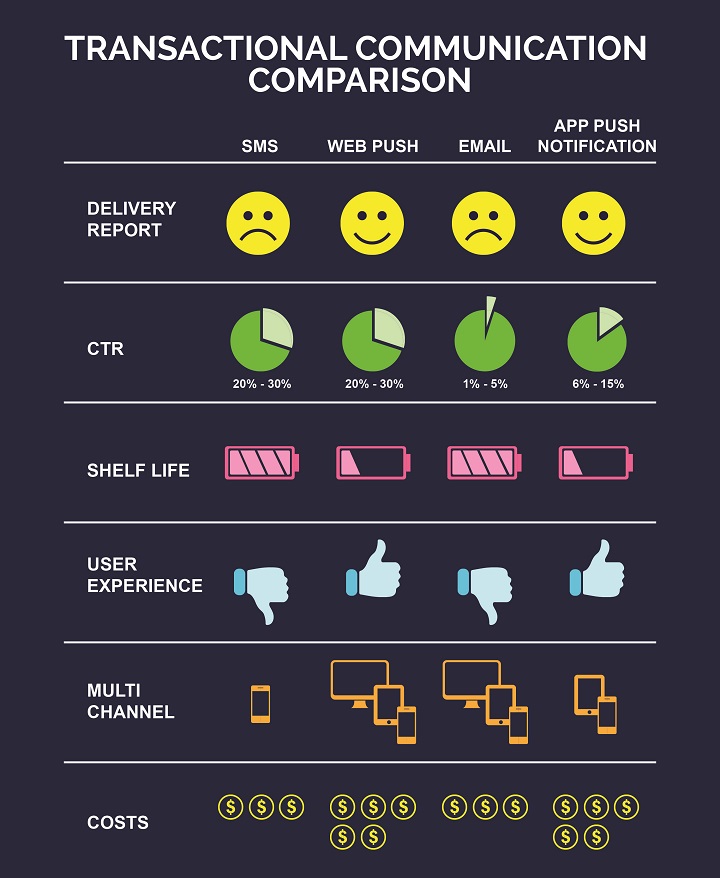
The channels have their own ups and downs. SMS is pesky, space consuming and irritating. Let’s be honest here, it’s old. If you want to make your mark in the present, then you need to move along (or ahead, as a matter of fact) to rise to your true potential. Almost everyone sends emails these days and it has become so ‘yesterday’. It’s time to pack your bags and move ahead of email. As far as web push and app push notification are concerned, there is no way that you can retrieve old notifications. Once you dismiss a message, it is gone forever.
All said and done, each channel plays a role to notify users. It up to you to fish out the advantages and choose which channel works best for you. Maybe you could get the best of some channels.
For example, you could send out major updates as emails and send constant updates as a web push message. You could mix and match, experiment and see what gives you better response, but keep an eye on your pocket as well.
91% of dissatisfied customers will not do business with you again. Therefore, transactional communication should take place with utmost caution.
The whole point of terrific communication is informing users before they even have time to ponder about it (more like a reflex action). When communication is seamless, giving users disruptive information, the user leaves happy. And we all know how happy customers can be good for you. Choosing the right mode of communication would make all the difference.
I don’t know about other channels, but if you want to try out web push notifications, we are right here 🙂 Log on to www.izooto.com to start pushing out notifications for free!

Pravya is a Product Marketer at iZooto. In love with animals more than humans, obsessed with amazing hair and educating the world about digital marketing. She secretly is mastering the art of stone balancing. Amidst all of this, she also squeezes out time to paint on canvas. Her dream is to go on a bike trip to the highest motorable road. She writes often on the iZooto blog.
Twitter handle – @pavipravin
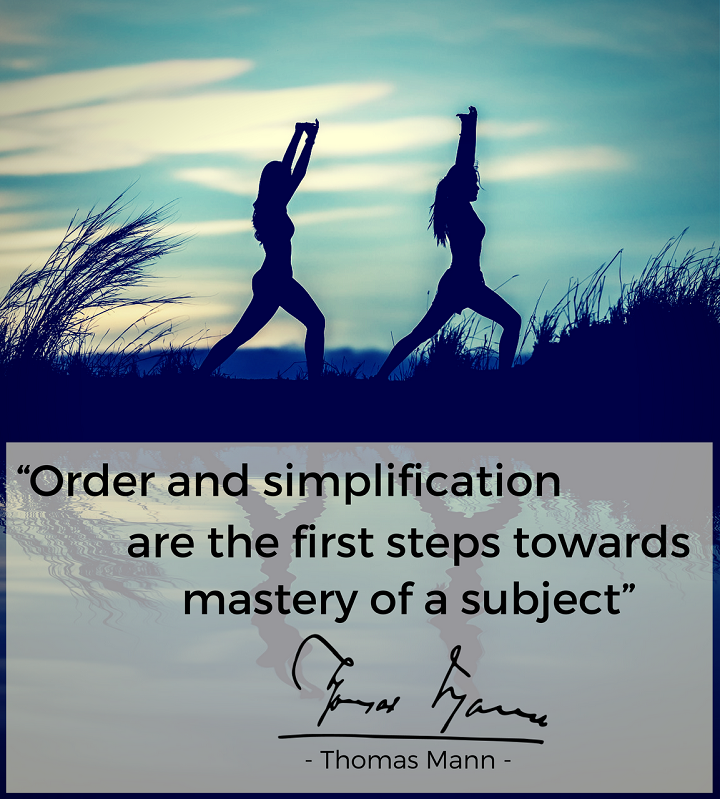
Save more abandoned shopping carts this year by developing a full cycle re-marketing system. Segment your shoppers into their respective groups based on their actions (or non-actions) and present each group with relevant messages that urges them to complete their transactions.
Have you ever visited an online store and then for weeks after seen that brand appear on your social media feeds and all across your regular news and shopping sites? That’s re-targeting at work. It’s part of a full re-marketing strategy.
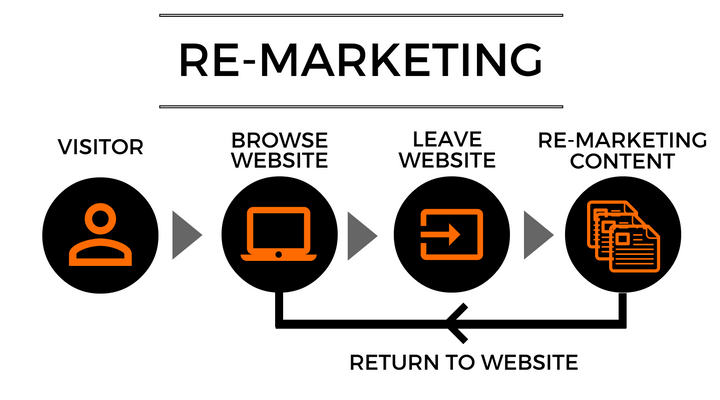
eCommerce presents the opportunity to offer a uniquely personalized experience to shoppers and is what sets us apart from brick and mortar stores. Test different tactics with each group and find what works best. New users who abandon their carts are likely to respond to promotions like first-time purchase discounts.
There are also those that visit your store multiple times and check out several different products, without making a purchase. You’ll want to monitor such activity and have separate campaigns with different messages for each of these user segments.
You also have the option of setting up automated re-marketing via services like Retai.ly which takes care of all the re-targting advertisements and helps you close sales from dropped users.
Think of your social network pages as a person, rather than online applications. Behave as though it is an actual human by interacting with people, making friends, and as with the offline world, don’t be afraid to make (a few) mistakes.
Share your joys and hopes and apologize for your shortcomings when they do occur.
Pick one social platform that you want. They each have their particular area of expertise with which to increase your skills.
Master Facebook

For example if you want to try social ads, Facebook is where its at. You can build very robust campaigns and bolster your marketing prowess through Facebook advertising.
Facebook has a tonne of options besides paid advertising. Join groups and engage with the communities, or create your own. Have you created events on Facebook before?
In fact, if you choose to be a master of Facebook, you’ll certainly have to take some time off your regular schedule to explore every nook and cranny on the platform. That way you’ll have a working idea of what sort of options you have available.
Jon Loomer has without question the top resources for mastering Facebook. If you’re looking to master Facebook marketing, go learn from the best.
Master Instagram
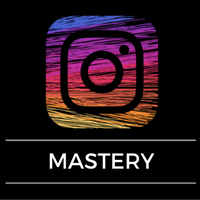
Instagram is great for those who are visually adept to showcase aesthetically pleasing visuals. However, even if you are design impaired (like myself…), it’s a very forgiving platform to improve your eye for design. The platform comes with a myriad of filters and tools to help you craft appealing images.
You can take your work to even greater heights with the help of third party online image editing software like Canva and Piktochart, which enable even untrained amateur designers to make stunning images that IG champions will appreciate.
Master Twitter
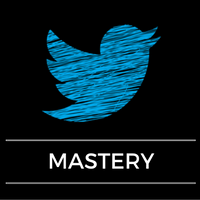
If you are a wordsmith then you will find Twitter to be your cup of tea. Twitter is all about honing your copy writing skills in 140 characters.
You can pair each post with images as well to tell an even more compelling story, but the real challenge is being able to craft the perfect message with just those limited characters.
That said, Twitter is no one trick pony platform. For example, you should create your own category lists like “Influencers”, “Ambassadors” or “Collaborators” and add relevant people to them. These lists can then be used for anything from content curation to content promotion, or any other creative ideas you might conceive.
Master YouTube
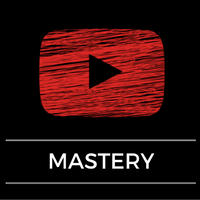
This is the platform for you if video content is your thing. It really doesn’t take a lot of learning before you have your first video up.
Video is where the bulk of audience engagement lies these days and YouTube is the place people go to search for videos.
Product videos do very well when placed on your product pages, and it also helps drive traffic to your page since people searching for product videos on Youtube (and other video platforms) will be able to follow links back to your site.
During the typical customer journey, people will search for reviews and tutorials of the products they are shopping for, so concentrate your efforts on those types for your product pages. However, don’t let that stop you from creating less promotional and more artistic videos to share with your audience, especially if they are relevant to your business.
Should this be your chosen mastery it will prove worthwhile in the long run as mastering it means by the time you have several dozen videos created, you will likely also have learnt as many new video editing and directing techniques.
All that on top of the numerous ways to promote your content and engage with your audience.
Whether it’s a back-end software to make your life easier (and grow your business), or a front-end app for your customers benefit, pick one and get it working at its fullest potential.
This can be anything from:
These technologies can be implemented with minimal effort (and minimal results), but to reap entirely the rewards of your investment, you should take the time to grasp how it works, learn the best practices and test it out yourself.
![]()
For example, implementing an analytics suite for your eCommerce store may seem like it requires comprehensive technical knowledge, but highly visual Drag’N’Drop software such as Mixpanel make the tasks achievable for even those with minimal tech savvy. At the end of the day you’ll have a ton of data shwoing how shoppers experience your site and which areas you should take steps to optimize.
Flash sale modules don’t even require much back end implementation, but learning best practices and how to implement them so both you and your shoppers enjoy the maximum benefit requires time and experimentation.
Learning to track and analyze link clicks will help you optimize your social media performance by showing you which posts get the most clicks. Eventually you will graduate to site wide tagging with a tag manager(the sort used by big league eCommerce players), but you’ll surely have someone or a team to implement it properly.
If you plan on only one undertaking throughout 2017 OR if the idea of expressing yourself by educating/entertaining people interests you, this should be it. Your blog content can be in any form, from a traditional written blog, to videos, image galleries, or even podcasts if can manage it.
Blogging is part of the content calendar, but I like to plan it separate from other content since I’ve done enough of both to know how to integrate the two efficiently.

For example I always leave space in my social media post schedule for when I know I’ll be publishing blog content so I can promote that instead. Sometimes I decide that the promotion of blog content will not be part of normally scheduled social posts but will be in addition to it.
The thing about blogging is that I spend most of my time promoting the content than creating it, so it reaches as many people as possible, thus driving more traffic to the site. So when I suggest blog regularly, I don’t mean to endlessly create content.
Rather, the entire cycle of blogging starts from research, moves to creation, then to publishing it. But it doesn’t end there, as this is when you begin relentlessly promoting it.
I use services like Epicbeat and Buzzsumo for finding types of content that people share a lot so I can figure out what I will create, as well as finding influencers I can reach out to on social media when I’m ready to promote to people who would find my content worth sharing.
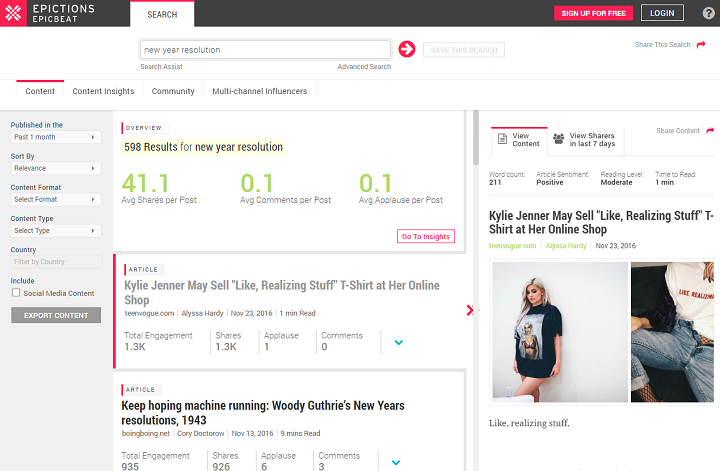
Keep in mind that although blogging and regular content updates have a significant impact on your search engine rankings, blogging for SEO is a long term goal that requires commitment and consistency to see results. Don’t jump in expecting to deliver an immediate surge of traffic to your site through blogging alone.
Have a look at other popular blogs both within and outside your niche. Besides giving you ideas about content and styles, it will keep you motivated and inspired to continue throughout the year.
Companies that leverage social events like valentines, children’s/father’s/mother’s day, school holidays, and Halloween have the advantage of staying in topical conversations.
I usually see F&B companies take the lead with topical promotions, but anyone can get in on it, even eCommerce merchants. February 5th is Super Bowl Sunday, consider creating a promotion that takes advantage of the amount of exposure the event receives, with a football theme or offering promotions related to the game.
Earth Day on April 22nd is when you could show your support for our collective home by donating a percentage of profits to earth-friendly causes, and remind your readers that by shopping online they are also helping to reduce their carbon footprint.
By planning and consistently running specific promotions centered around such events, you are building brand awareness by being in hot conversations. Planned correctly, you should also see increased seasonal spending with your brand.
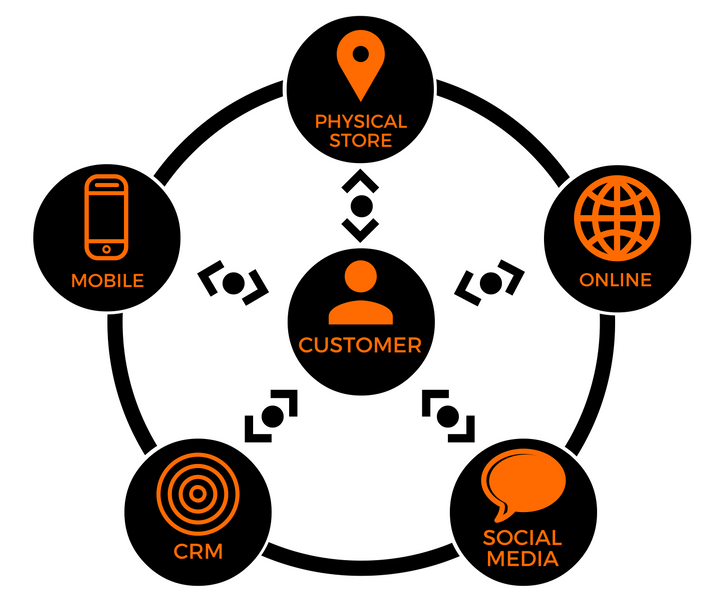
Take the time to grow your brand on previously untouched channels. If you’ve never sold on Amazon before, now is the time to think about being a merchant on their platform. Or if you’re in the arts and crafts market you could do well on Etsy.
When the time is right you will even want to take your business to the physical dimension, but for now, just make sure your brand is visible everywhere on the internet.
You should be being willing to sell anywhere and everywhere that there are customers willing to pay you for your products. The other benefit of having multiple sales channels is that you won’t be left in the lurch if it fails for any reason.
Next time you tend to non hush-hush business operations, consider documenting or even live streaming it as an event.
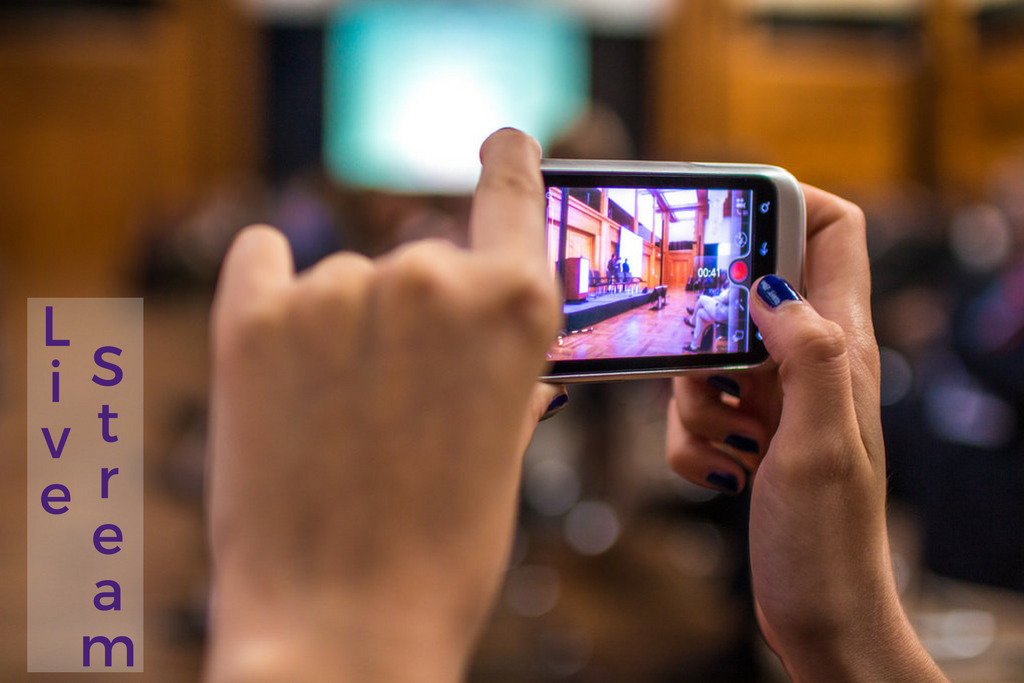
In the past I worked at an IT hardware distribution company. Every time we got a new shipment of products in, it was cause for celebration because our target market would get really excited about new arrivals and updated stocks, especially if they had been waiting for new supplies.
Our CEO would take photos of the delightful new goods and post it on our media pages himself because it was so effortless to engage in such an rewarding manner with our audience. It wasn’t a time where live streaming such events would have been a priority enough to go through the hassle of setting it up the tech for it, so photos sufficed.
Now, technology has advanced to the point where all you need is your phone and you can live stream events that your audiences will enjoy: a behind the scenes look at what goes on with your business.
This sort of content gives life to your organization. The human touch will help you seamlessly engage with the public you want to reach because sharing your routines gives your audience a glimpse into the actual human beings behind the products and services you offer.
Every product makes a promise to the buyer: to change their life for the better. Before buying, however, people want to see how -and in what context- a product is used. If you choose to improve your product image aesthetics, then start by adding lifestyle images to your product pages.
Lifestyle product images sell a customer on a piece by helping them visualize it in context since they display your product features in real-time. The common white backdrop product image won’t tell a story.
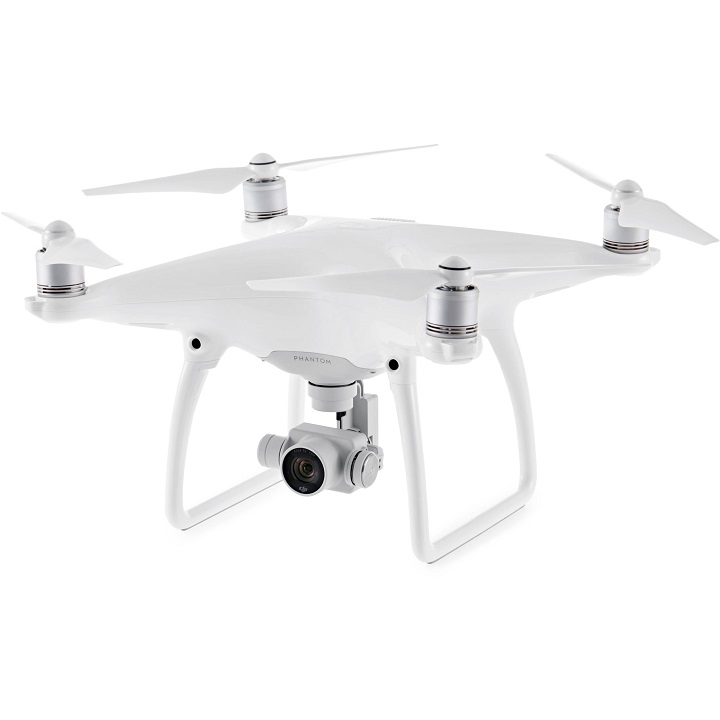
The DJI Phantom 4 is shown clearly against the typical white backdrop. It’s a good quality image but without context it lacks the ability to evoke emotion, or convey any meaningful information.

In this case the Phantom 4 is displayed with context! Looking at the image you can clearly see the size of it, which I couldn’t from looking at just the first image.
Imagine if this were a thermostat or desk and all you had was the first shot. You make the purchase but when it arrives it might not fit in your space. Having a lifestyle image would have given you the information you needed to decide perhaps it would be better suited elsewhere.
This is information you can help customers to glean from product images. After all, eCommerce merchants need to make up for the lack of tactile fulfillment that physical retailers can offer.

When you want to take it to a whole new level, these sort of lifestyle images -ones with the product in action- have the ability to inspire emotion and imagination in customers. Someone viewing it will start fantasizing about possibilities and envisioning scenarios of how they would use it if they had it themselves. Powerful indeed.
Have a look around J!NX store. They do a fine job of:
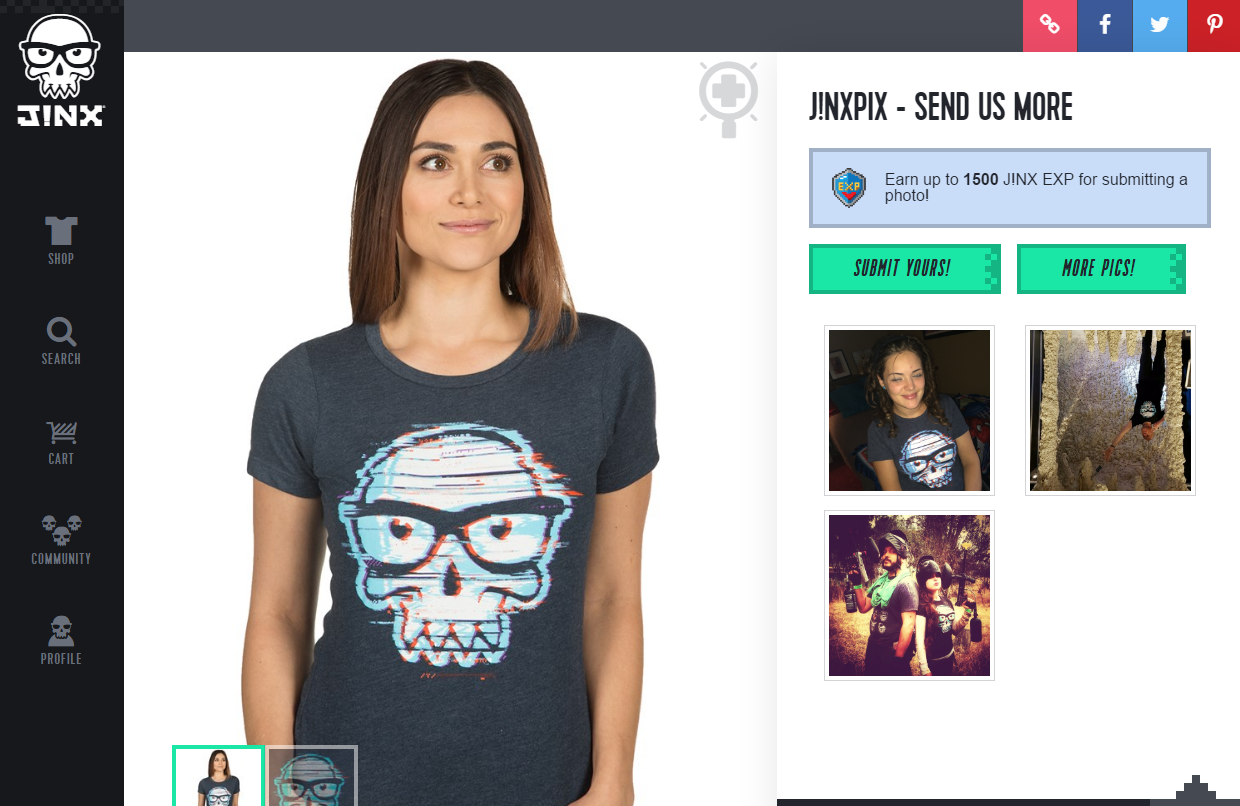
If you’ve an abundance of energy, produce and add several lifestyle images, then go a step further and devise a plan to get your customers on board by hosting pictures of them with their purchases. You can entice customers to participate by gamifying the process or rewarding them for each post they make, but really, gamification is an entire topic of its own.
If you enjoy planning and keeping activities organised, there’s a good chance you already have a content schedule in place. If not, this could be your time to start, at least for keeping your social media organized.
I limit each period(month or quarter) to a maximum of two general themes. For example if running a baby/motherhood website, I’d focus on mothers as well as families during the month of May (women’s day), and dedicate November for content focused on children (children’s day).
As with a blogging content calendar, be topical but also try to stay relevant to your industry.
I use a simple Google spreadsheet to plan and keep track of everything, but you can use Excel if you prefer. Personally I hardly do anything on local (being a digital marketer and all) so I use Google Sheets. I find it sufficient for these sort of tasks since it’s live, shareable instantly, and I can link between documents, sheets and presentations easily.
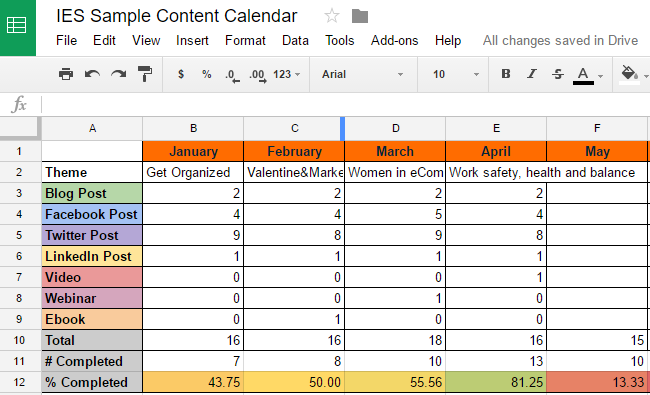
This is our yearly outline sheet. In it I include periodic themes and schedule the minimum amount of content to be produced. Since this is a new year resolution post, you may find it helpful and motivating to see your progress. To that end I’ve included two rows that show completion rates for each month as well as a yearly summary.
Add whichever channels you produce content for and determine your posting schedule. If you’ve no idea how much you can take on, don’t worry. Start small and do what you can. If you are already pressed for time there’s no point planning for 10 posts a day if you’re not able to execute it.
Instagram and Pinterest are not strong channels for us so eventhough InstanteStore does have official accounts on those platforms, I don’t plan for content promotion on those channels. I prioritize tasks to leverage where our strengths lie, and you should too. So if you find IG effective to reach your audience compared to Twitter then prioritize that and add it to your plan instead.
Things like videos take more time and effort to make, so I schedule it more conservatively, perhaps once a quarter or even a year. A webinar could double as the video content so I schedule it for before the video content.
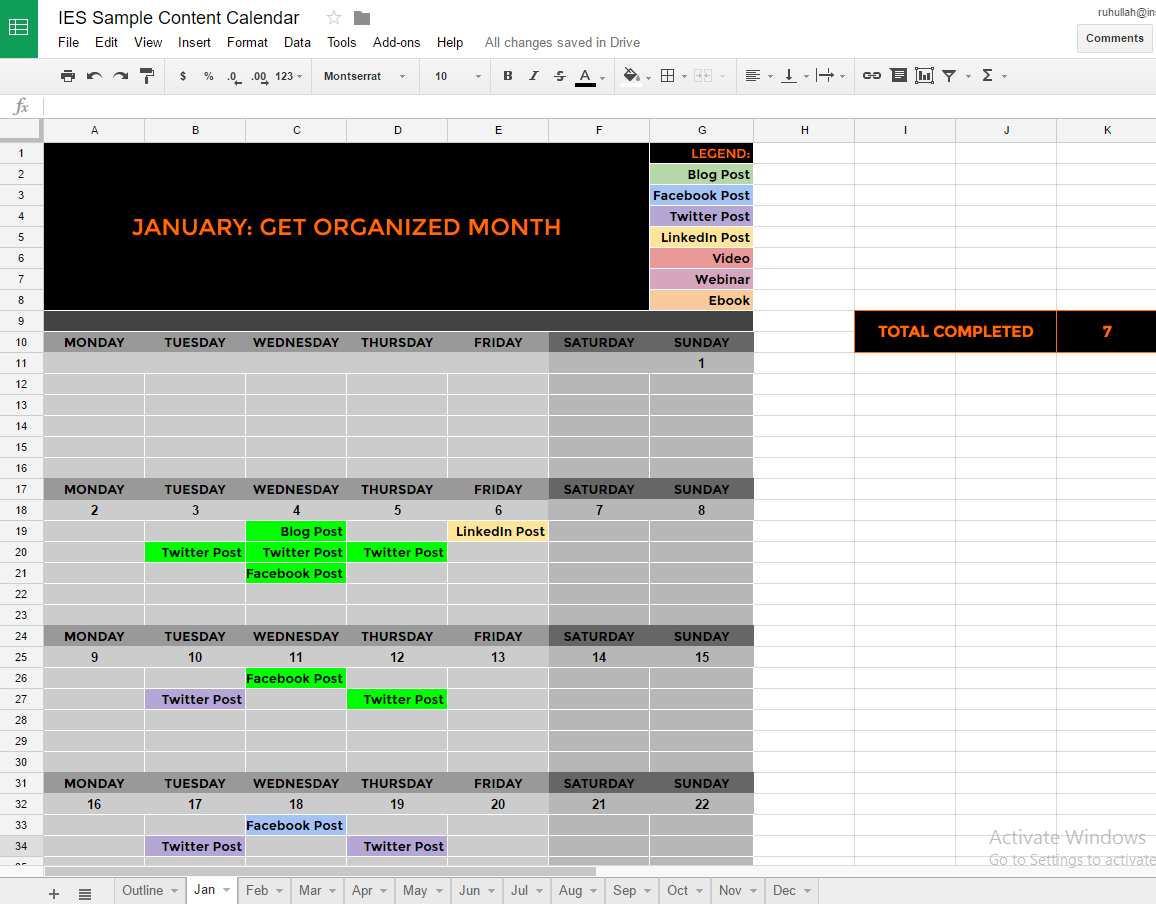
On the following sheets are the monthly views that go into detail about the daily activity for each month, with auto-updated counts for total of posts per month. Remember I said I can easily link between documents? This is where I do just that.
It’s an immense quality of life perk that each item on the monthly view is linked to the my content creation slides (I just happen to use slides) for easy reference, and it takes me to a page like this one:
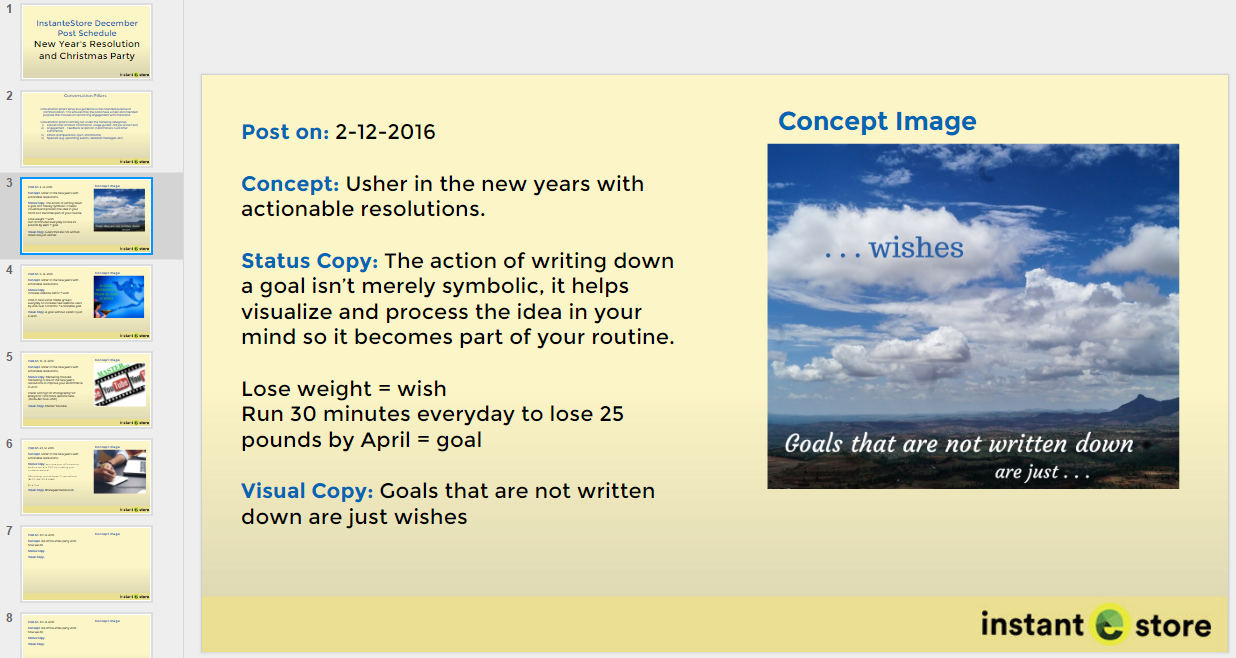
This is the crafting bench, so to speak. I use Google Slides as a canvas to draft concepts and the content copy, as well as come up with ideas for the post visuals. The image above shows the final result of a fully drafted post. In this case the posts are the pre-emptive messages before the actual blog post, which is the one you are reading right now.
With the entire year mapped out, it will free up the rest of your calendar for other priorities, or even leisure! You don’t have to create content for the entire year right away, but having a structured content plan in place will help you stay ahead of deadlines while keeping your mind clear and focused on your goals.
These are merely examples of how we plan our content calendar. You’ll discover your own methods and preferences and tailor your content schedule to suit your own style once you find your groove = )
Once again, thanks for reading our eCommerce blog. We hope you’ve found it valuable. We’re looking forward to becoming the top eCommerce blog of 2017 (and beyond)!


Are You Using THE ONE Proven Tactic to Boost You Black Friday Sales By Up to 320%?
It’s that time of the year again!
Did you know that there are less than 4 days before the biggest sales period of the year? Both Black Friday & Cyber Monday are set to rake in the lion’s share of sales this season as holiday shoppers scour the web for the best deals.
So is your eCommerce store ready for the year end shopping galore? What have you prepared to OFFER your customers?

Ah, search engine optimization. I have a strong love-hate relationship with the artform. I’m certain its true for anyone who has the will to dabble in the arcane craft of SEO.
Alas! SEO for eCommerce websites is even more complicated and mystical than traditional SEO. In the everlasting quest for the holy grail of Google’s first result ranking, many throw our hands up in despair and resign from the task altogether. Some persist doggedly, adamant that SEO “must-be-done”.
Fewer still go about it in a practical & time efficient manner, tackling the problem with a mixture logic and creativity, never actually enjoying it.
Of course, InstanteStore comes with a built in “SEO Wizard” to help you take care of the back-end and technical aspects of SEO, like Schema implentation. There are still practices that you should undertake to build upon that foundation.
I’ve been studying a whole bunch of eCommerce websites, so I’m sharing several good and bad trends I’ve noticed among merchants in 2016. The craft may seem mysterious in theory, but practically, the execution is often straightforward.
The most common issue I notice when browsing shopping websites is the amount of duplicated content. This usually stems from having multiple product pages for variations of the same item. Fix it by making sure all variations (size, colour, material) are on the same product page and displayed via drop-downs or radio buttons. We know search engines are contemptuous of duplicate content, providing zero value to audiences. So let’s make this a forbidden practice. The tech exists for this fix, hence a technological obstacle is no excuse for it.

An even weaker version of the duplicate content affliction is copy pasting supplier product descriptions, often to the point where many merchants have the same exact copy. I’m glad to report that it’s not something I notice much anymore, but it does happen so I’m just letting you know: this is sooo forbidden, there should be a wall of “NOPE” around it. If your products suffer from contentimus duplicatitis, do whatever it takes to make it original. Hire a copywriter if you must to make sure your product pages don’t contain copy that anyone else has.
It’s not efficient to create unique copy for thousands of product pages though. Instead, using your web analytics tool (you have one right?), pick your most popular product pages for original content.
Another problem I often encounter is the worrying lack of search query optimization. Unless you sell iPads or a popular product, don’t use product names as your search indicator. Instead target the product type: tablets, insect repellent, autumn chrysanthemum arrangements, Halloween cookies, etc.
Think about what the shopper is searching for-what they actually type into search engines when they begin their digital journey. This will help determine the kind of language used to reach your pages. So if your insect repellent is called “Bugone”, maybe people will be more likely to find it if you optimized for the search term: “bug spray”, or “insect repellant”.
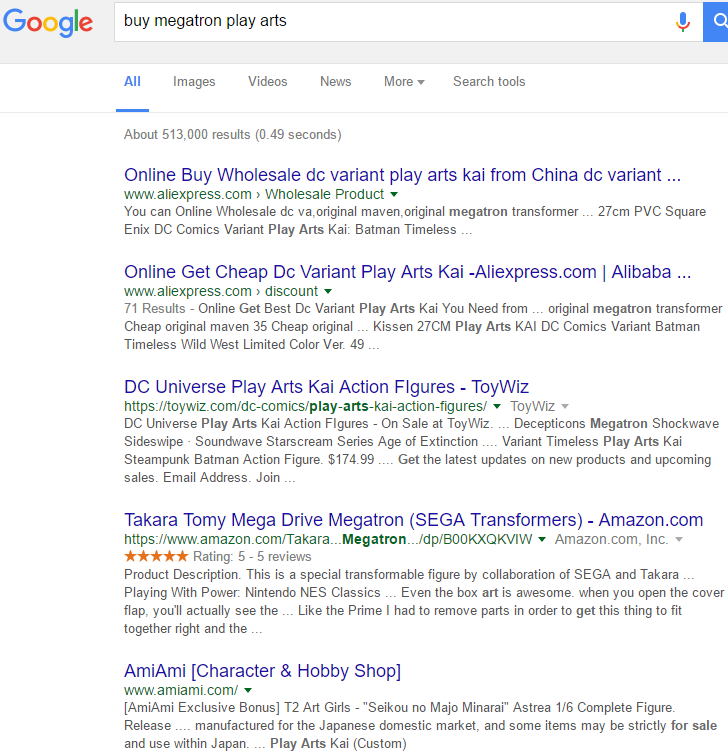
Search engines (and people too) love it when a page matches the users intent exactly. It’s logical. So if a page matches a shopper persona, it should show up when a person in searching for information. If a page matches a buyer persona, it should be listed when the person is ready for product options.
Atop a meadow of clouds, perched firmly at the top of SERPS is Polyvore. It’s a fashion shopping site, where they know their audience well and the social tech they favour. They have thus given shoppers the ability to create bundles of products, making up their own styles that they can upload so other users can browse and shop. Users can also interact with other bundles and share them across social media.
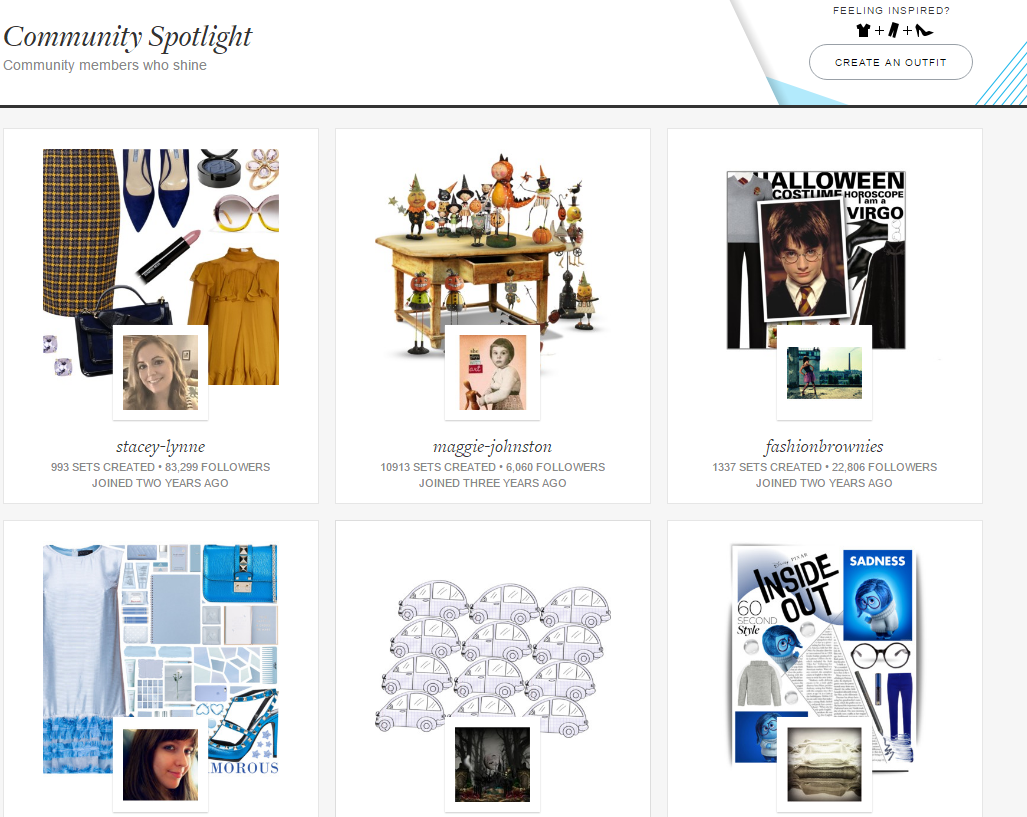
I’m pleased to say that I’ve noticed an increase in merchants opting for user generated content. This is great for SEO because it means older indexed pages are regularly updated, letting search engines know that your pages still have activity and thus are still relevant. Up till recently, user generated content was mostly in the form of user reviews and testimonials. As companies like Polyvore show us, there’s more than one way to skin this dragon!
User generated content is beneficial in several ways:
As mentioned above, new content keeps your pages refreshed and indicates activity to search engine bots. It’s why online forums do well at SEO.
The community your create benefits from it as well because they get recognition for putting together popular outfit ensembles, creating an enjoyable user experience.
J!NX clothing give their shoppers the ability to post pictures of themselves with their new loot, and earn rewards for it too:
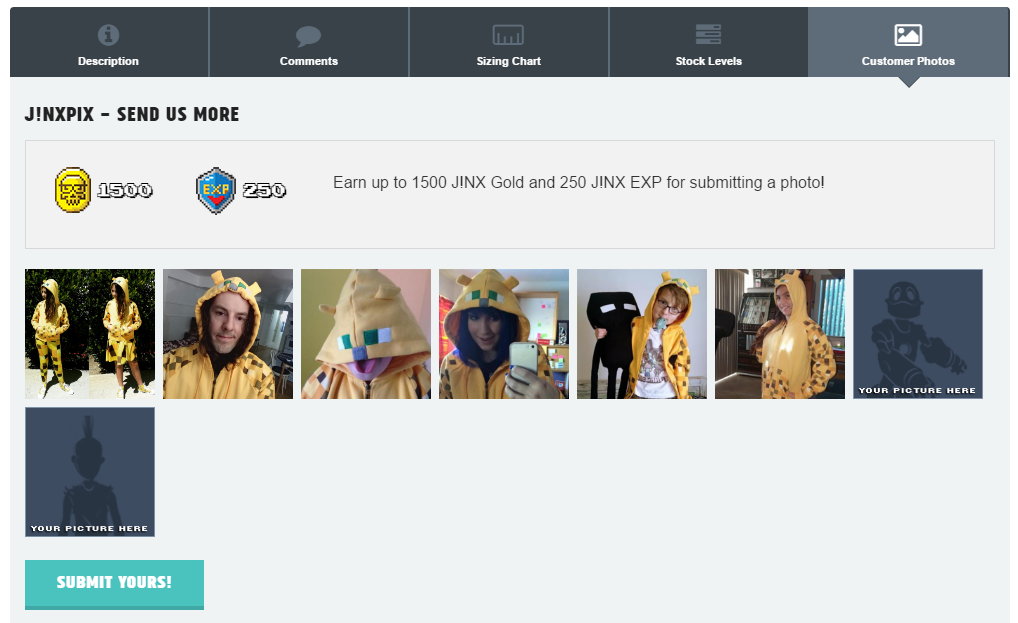
A quick and simple fix for user generated content is to add social media feeds to your most popular pages. This is a good strategy if you don’t have much engagement on your site but have a responsive audience on your social media channels.
*Remember that people want to engage with brands they see, so don’t hold back. On social media you should be tagging your posts with relevant people, and make use of those #tags to get your content in front even people who would otherwise not be able to see your content.
Social Media Marketing. SEO is no longer confined to making search engines like your pages and content. It’s now more important to make your content visible (and popular) on different channels on the web, because people who engage with your content are indicting to search engines that your content is relevant. Hence the more people engage with it, the more priority search engines will give it.
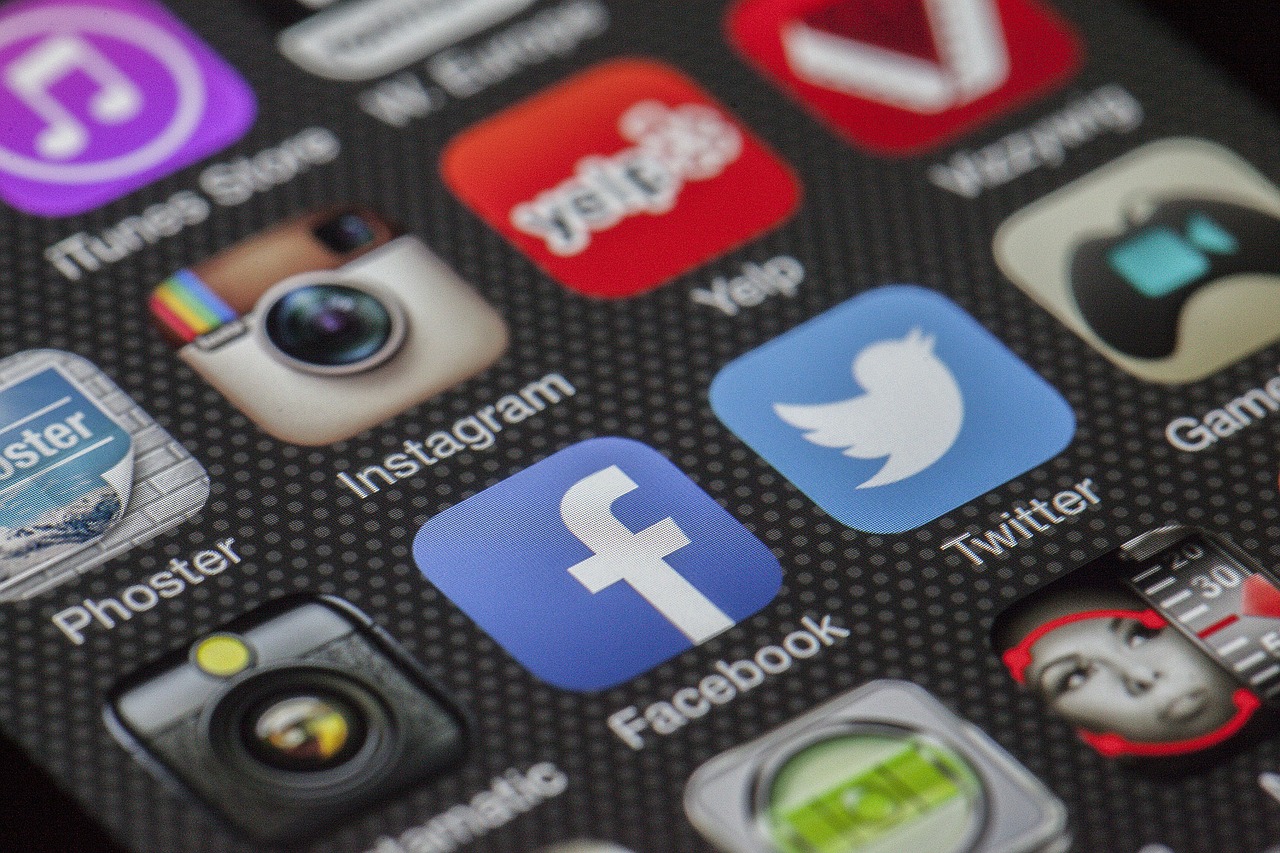
It’s the reason you’ll see outdated content on the first page of many results, because it was once the most popular result for a search, and nothing new has come along that is as popular, even if there are more relevant contemporary piece available.
These channels include the various social media platforms like Facebook, Instagram, Twitter, Youtube (yes!) as well as community forums.
In the past, back-links used to hold a lot of weight in SEO ranking, so much that internet marketers hacked the system and created lots of artificial links a ranking boost. Given enough effort a page could rank number 1 on Google with a day or two. Naturally this led to a poor experience for the user, and so things aren’t as simple anymore.
So my suggestion is this: the next time you are on Facebook, spend a few minutes to join a group relevant to your market and promote your own content with a link and a few words about it. I’m not even talking about a blog post-though it can be. I’m talking about a specific product. I say start promoting a product you personally use because it will help word your promotional post in a fluid and genuine manner. Use that as practice before writing about products you aren’t as passionate about and springboard yourself into a natural rhythm.

If you do this for a single piece of content on multiple groups, across various social networks, you will start to get in front of many eyeballs. That’s a great first step. Once your foundation is solid, audience engagement will be an easier obstacle to demolish. If you can only spare time to promote one piece of content to one group, once a week, that is infinitely more than getting zero social signals. So do it for as long as you can before losing yourself to the void…
The key to tying social media with SEO is the user engagement. The goal is to have lots of people sharing your content over a short period of time, which is the “virality” factor that a social media marketer so intensely craves. It isn’t necessary to go all Ice Bucket Challenge every single time. What works in the long run is the cumulative effects of content promotion.

As with anything digital, always be tracking and analysis your traffic, your search terms and your rankings. Figure out what’s working and replicate the process from there. A methodological process will ensure you start getting results faster.
As you can gather, social interaction has a significant role in contemporary SEO, although many traditional tactics do still carry weight. It’s all about the ratio of importance the engines assign to each ranking factor.
Doing SEO by bolstering my social media marketing efforts works well for me. It covers all my priorities: achieving KPI goals, what I have time for, and what I enjoy. Try something yourself and see what works best for you based on what you can manage to get done.
Mastering SEO isn’t for everyone, but it doesn’t mean only the most seasoned practitioners are capable of conjuring clever spells. You’ll see that most of the time you’ll be getting incremental results over long periods of time. Once in awhile, stars align and magic wills itself into being without much help, resulting in a massive surge of traffic, engagement and popularity. It’s an incredible rush to see it happen before your eyes as weeks and months of work pay off all at once!